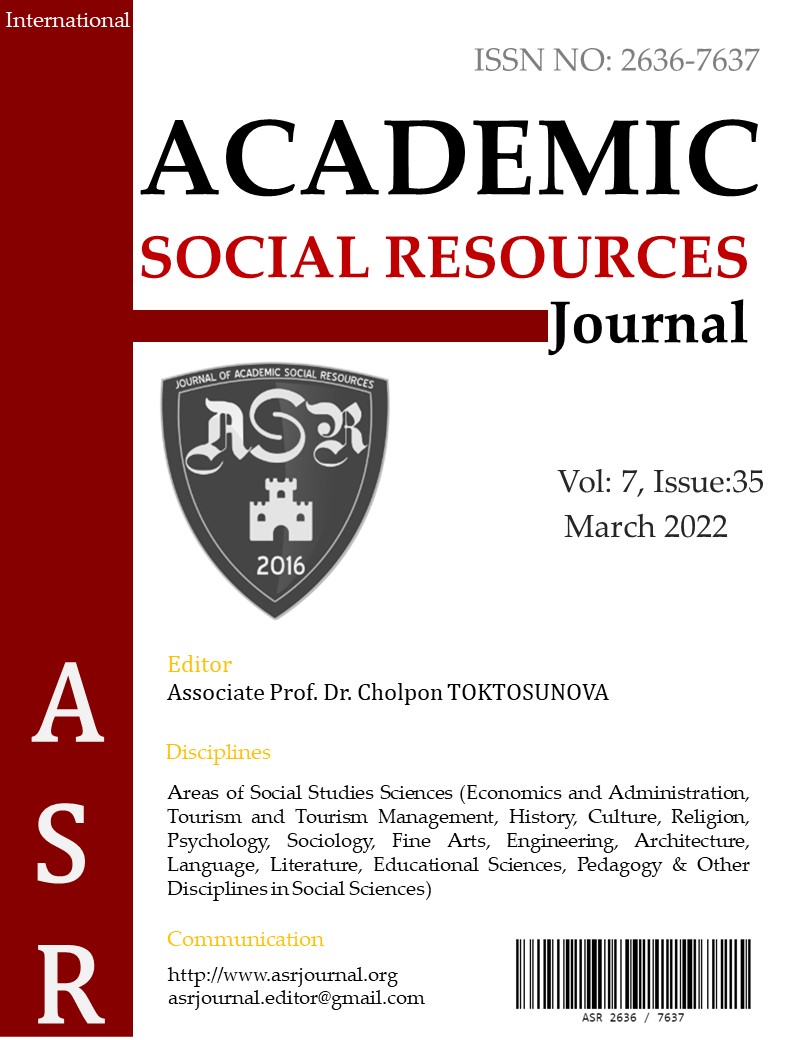Author :
Abstract
Ondördüncü yüzyılda modern düşüncenin temeli olan nominalizm hareketinin öncüsü olarak kabul edilen Guillelmus de Ockham, metodolojik sadeleştirmenin de temelini atmıştır. Ockham Usturası olarak kabul edilen bu felsefe, bir konuyu en doğru ve anlaşılır şekilde anlatmanın yolunu gereksiz ayrıntı ve unsurların elenmesiyle sağlanabileceği fikrine dayanır. Konstrüktivizm, De Stijl, Bauhaus gibi akımların yanı sıra doğrudan sadeliği benimseyen Minimalizm akımlarının başlı başına bu fikirlerden yola çıkmış olabileceği düşüncesi ütopik sayılmaz. Fakat bu çalışmada, tüm bu akımlar bir yana bırakılarak sanat hayatı boyunca eserlerinde bambaşka üsluplar benimseyen Mark Rothko’nun kariyeri göz önünde bulundurulacaktır. Çünkü sanatçı kariyerinin başlarında sıradan figürlerle çalışırken zamanla sürrealizmin etkisinde kalmış ve mitolojik sembollerle ilgilenmiştir. Sanatçının kariyerinin son dönemlerinde ise çalıştığı devasa çerçeveleri ve monokrom renkleri sanatının da devleşmesine yol açmıştır.
Yüzyıllar öncesinde öngörüler veya tecrübeler neticesinde temelleri atılan Ockham Usturası’nın yirminci ve yirmibirinci yüzyılda sanat çerçevesinde hala kabul edilebiliyor olması bu çalışmanın çıkış noktası olmuştur. Geniş bir literatür araştırması yapılarak Guillelmus de Ockham’ın yaşamı ve felsefi bakış açısının yanı sıra Mark Rothko’nun Ockham Usturası felsefesine uygun üslup değişimine değinilmiştir. Dijital kaynaklardan elde edilen Rothko’nun eserleri Ockham Usturası felsefesi üzerinden incelenmiş ve sonuç olarak, dönemsel veya bireysel olarak felsefi bakış açılarının zaman zaman kabul görebileceği kanısına varılmıştır.
Keywords
Abstract
Guillelmus de Ockham, who is considered to be the pioneer of the nominalism movement, which is the basis of modern thought in the fourteenth century, also laid the foundation for methodological simplification. This philosophy, which is accepted as Ockham's Razor, is based on the idea that the way to describe a subject in the most accurate and understandable way can be achieved by eliminating unnecessary details and elements. It is not considered utopian to think that Minimalism, which directly adopts simplicity, as well as movements such as Constructivism, De Stijl, Bauhaus, may have started from these ideas. However, in this study, leaving all these trends aside, the career of Mark Rothko, who has adopted a completely different style in his works throughout his artistic life, will be considered. Because while the artist was working with ordinary figures at the beginning of his career, he was under the influence of surrealism and was interested in mythological symbols.In the last period of the artist's career, the gigantic frames and monochrome colors he worked with led to the giantization of his art.
The starting point of this study is that the Ockham Razor, whose foundations were laid centuries ago as a result of predictions or experiences, can still be accepted within the framework of art in the twentieth and twenty-first centuries. An extensive literature search has been made, and besides Guillelmus de Ockham's life and philosophical perspective, the stylistic change in accordance with Mark Rothko's Ockham Razor philosophy has been mentioned. The works of Rothko, obtained from digital sources, were examined through the philosophy of Ockham's Razor, and as a result, it was concluded that periodic or individual philosophical perspectives can be accepted from time to time.
Keywords
- Ahmetoğlu, Ü. (2011). “Soyut Dışavurumculukta Anlam ve Renk Zenginliği”. Yüksek Lisans Tezi. Atatürk
- Ahmetoğlu, Ü. (2011). “Soyut Dışavurumculukta Anlam ve Renk Zenginliği”. Yüksek Lisans Tezi. Atatürk Üniversitesi, SBE, Erzurum.
- Ambrosse, G. ve Harris, P. (2017). Grafik Tasarımın Temelleri. Literatür Yayınları, İstanbul.
- Antmen, A. (2009). Sanatçılardan Yazılar ve Açıklamalarla 20.Yüzyıl Batı Sanatında Akımlar. Sel Yayıncılık, İstanbul.
- Arndt, N. (2011). “Alienation and Artistry: The Life of Mark Rothko”. On Stage. September - December 2011, sf.Arslan, S. (2021). “Sanatta Tekinsizlik ve Uzam İlişkisi Üzerine”. Sanat Dergisi. (38), 469-487. Doi: http://doi.org/10.47571/ataunigsfd.971407
- Avşar Karabaş, P. & Yıldız, G. (2016). “Soyut Dışavurumculuk Akımı Kapsamında Renk Alanı Resimleriyle MarkRothko.” Uluslararası Kültürel ve Sosyal Araştırmalar Dergisi (UKSAD), 2(2), 351-364. Retrieved from https://dergipark.org.tr/tr/pub/intjcss/issue/30959/336605
- Balkan, İ. (2021). Ockham’ın Usturası (İnanç Kanı ve Kanaat Üzerine Morfolojik Bir İnceleme). Kanon Kitap,Bayındır, A. (2014). “Ockhamlı William’ın Din Felsefesi”. Doktora Tezi. Uludağ Üniversitesi, Felsefe ve Din Bilimleri Ana Bilim Dalı, Bursa.
- Beraha, A. (2021). Bilimsel Düşünce ve Araştırma Metodolojisi Kavramlar, İlkeler, Bilim Felsefesi ve Ontolojik Boyut. Gazi Yayınları, Ankara.
- Bersani, L. ve Dutoit, U. (2006). Fakir Sanat Beckett - Rothko - Resnaıs. (çev. Suat Kemal Angı). Dost Kitabevi Yayınları, Ankara.
- Bingöl, M. (2019). Ockhamlı Wıllıam’da Bilgi, Mantık ve Metafizik İlişkisi. Doktora Tezi. Atatürk Üniversitesi, SBE, Erzurum.
- Dülger, F. (2017). “Alberto Gıacomettı, Mark Rothko ve Katsushıka Hokusaı’nin Resimlerinde Boşluk Kavramının Yeri”. Yüksek Lisans Tezi. Mimar Sinan GSÜ, GSE, İstanbul.
- Falls, R. (2011). “Why Red? (From The Artıstıc Dırector)”. On Stage. September - December 2011, sf. 1).
- Hogan, E. (2011). “Pictures as Dramas, The Work of Mark Rothko”. On Stage. September - December 2011, sf. 2- Lopez-Remiro, M. (ed.) (2006). Writings On Art Mark Rothko. Yale University Press, London.
- Malkondu, T. (2018). “Soyut Dışavurumcu Sanatta Mark Rothko ve Barnett Newman’ın Renk Alanı Yaklaşımlarının Karşılaştırılması”. Yüksek Lisans Tezi. Giresun Üniversitesi, SBE, Giresun.
- Maurer, A. (ed.) (1999) “The Philosophy of William of Ockham: In the Light of Its Principles”. Toronto Ont.: Pontifical Institute of Mediaeval Studies.
- Selz, P. (2017). Mark Rothko. The Museum of Modern Art., New York. https://assets.moma.org/documents/moma_catalogue_2557_300062218.pdf
- Ural, Ş. (2011). Basitlik İlkesi, Kabalcı Yayınları, İstanbul.
- Uzun, B. (2017). “Tümeller tartışmasına yeniden bakmak: Anselmus ve Ockhamlı William’da Tümeller ve Kötülük İlişkisi”. Yüksek Lisans Tezi. İstanbul Medeniyet Üniversitesi, SBE, İstanbul.
- Yalur, E. (2020). “Tasarım İlkelerinin Afiş Uygulamaları Üzerinden Anlatımı.” 9. Uluslararası Meslek Yüksekokulları Sempozyumu, 18-20 Kasim 2020, 108-118.
- Yalur, R. (2018). “Minimalist Sanat Akımının Türk Afiş Tasarımına Etkisi.” Sanatta Yeterlik Tezi. İstanbul: Arel Üniversitesi, SBE.





